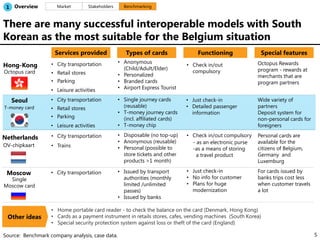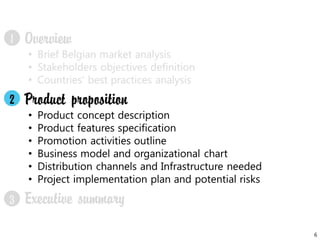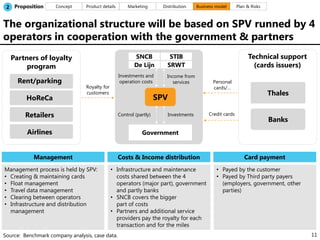SNCB Online Challenge Solution by Benchmark company at Solvay Business Game 2013
- 1. 17 February 2012 Single card for network mobility: creating multifunctional loyalty system in Belgium
- 2. 2
- 3. cv 3Source: Benchmark company analysis, case data. Current ticketing system isn’t perfect and definitely there is a room for improvement 1 Overview Stakeholders BenchmarkingMarket Infrastructural hubs of networked mobility are being created around stations… … but still all services require separate cards and there’s no single solution for network mobility Separated Blue-bike card required (Subscription €10 + usage payment) Single tickets/MOBIB card required (unified urban transport card) Cambio Card required B-Parking card/single ticket required 0 20 40 60 80 100 2011 20122010 Cambio-locations Cambio-cars Parking areas near stations built in 2010-2012 Tickets bought online/in the ticket office required Service Type of ticket/card Bike rental Car rental Parking City transport Trains Number of Cambio car rental locations and cars provided near stations The integrated ticketing system to simplify network mobility should be implemented
- 4. cv 4Source: Benchmark company analysis, case data. The new model should meet goals of key stakeholders: the government, citizens and 4 transport operators 1 Overview Stakeholders BenchmarkingMarket Operators Citizens Stakeholders Specific objectives and conditions of stakeholder Shared goals • Faster boarding and changing transport • Minimize offline ticket sales, automatic card charging • Smart pay-as-you-go system • Easier, low-threshold transport for the customer • Stimulate a technical compromise between operators • Reduce pressure from car traffic on the cities • Operators' independence • Remain current ticketing during the new system implementation • Improve 3rd Party Payer system • Decrease fraud • CRM at the level of individual customer • Phased transition to smart card • Good cost to profit ratio • Continued compatibility with the current fares • Maintain the role of the train conductor • Separate customer management and fares offering Government
- 5. 5Source: Benchmark company analysis, case data. There are many successful interoperable models with South Korean as the most suitable for the Belgium situation 1 Overview Stakeholders BenchmarkingMarket Hong-Kong Seoul Moscow Types of cardsServices provided • Home portable card reader - to check the balance on the card (Denmark, Hong Kong) • Cards as a payment instrument in retails stores, cafes, vending machines (South Korea) • Special security protection system against loss or theft of the card (England) Netherlands OV-chipkaart T-money card Octopus card • Issued by transport authorities (monthly limited /unlimited passes) • Issued by banks • Just check-in • No info for customer • Plans for huge modernization - as an electronic purse -as a means of storing a travel product • Check in/out compulsory • Anonymous (Child/Adult/Elder) • Personalized • Branded cards • Airport Express Tourist • Single journey cards (reusable) • T-money journey cards (incl. affiliated cards) • T-money chip • City transportation • City transportation • Trains Octopus Rewards program - rewards at merchants that are program partners • Disposable (no top-up) • Anonymous (reusable) • Personal (possible to store tickets and other products >1 month) Personal cards are available for the citizens of Belgium, Germany and Luxemburg • City transportation • Retail stores • Parking • Leisure activities Functioning Special features • City transportation • Retail stores • Parking • Leisure activities For cards issued by banks trips cost less when customer travels a lot Other ideas Single Moscow card • Just check-in • Detailed passenger information Wide variety of partners Deposit system for non-personal cards for foreigners • Check in/out compulsory
- 6. 6
- 7. 7Source: Benchmark company analysis, case data. We offer the simple interoperable ticketing model that fits stakeholders conditions… 2 Proposition Product details Marketing Distribution Business model Plan & RisksConcept 1 Please, refer to the next slide to look at the product features deeply 2 Including current fare types of different operators. At the heart of the system there will be a multifunctional payment & loyalty chip card for Belgians with a smartphone chip option and non-personal rechargeable & reusable chip card made primarily for foreigners Producttypes Fare types Services provided Issuers Banks SPV SPV SPV Pay as you go Seasonal 2 Pay as you go • ID card linkage • Provides maximum variety of services of new ticketing model • Deposit payment required • All features of chip card are included • The main difference is an integration with customer smartphone • No linkage with ID (for non-residents) • Rechargeable and reusable: one can buy the card, charge/recharge it and then return it in the exchange of deposit value Loyal Pay as you go Seasonal 2 Users Belgian citizens Belgian citizens Foreign people Public transport Additional services E-money Public transport Additional services E-money Public transport Additional services
- 8. 8Source: Benchmark company analysis, case data. …and has great features in terms of services provided, loyalty program breadth and different types of issuers and fare types 2 Proposition Issuers and fare types Product features Short description Services Loyalty program • Public transport services is the heart of the system • Includes services of 4 operators (trains, buses, trams, subway) • The interoperable concept will include car parking, rental of bikes and auto, leisure activities and so on (provided by operators and its partners) • The wide loyalty program will allow to use the card to pay in retail stores and other partners • There will be an opportunity to use for Internet payments + - • The program will include transport operators and wide variety of partners that give users miles points for every usage of its services • Factors defining the amount of points: type of service, type of customers amount of purchase/length of trip/traffic absence, intermodality combination and so on • Points will be used to pay for any services provided by the whole loyalty system • Opportunity to transfer points or donate them • SPV will issue the majority of cards and give the issue rights to the banks • Banks will issue co-branding cards that contain special bonuses provided by them • Pay as you go – smart system that allows consumer to use the products at the optimal price • Seasonal – fare for the certain time periods (incl. the option of separate or combined usage of services) Product details Marketing Distribution Business model Plan & RisksConcept
- 9. Develop mobile/web application with wide gamification options based on mile points that stimulates people to use product more, compete with each other, etc (together with exploring all information about the services) 9Source: Benchmark company analysis, case data. The only way to succeed with such product is to inform citizens, involve them into its creation and stimulate to use 2 Proposition Stimulating to use it Reach quantitative and qualitative growth by offering different incentives and providing customers with the unique experience Getting to know it Spread the idea of new ticketing model by involving customers to creation process, educating them and stimulating word of mouth 21 Involve Belgian citizens into product development through creation of discussing crowdsourcing platform and surveys “Make your future experience awesome” (channels: official site, social networks) Create simple and clear “how to” guides and brochures emphasizing advantages of the card and the importance of wide card penetration (channels: official site, social networks partner sites, advertising on transport) Stimulate customers to spread the word about the project via social networks and word of mouth (#, by offering the most active users options of cards pre-order and welcoming mile points) Inspire people to switch to the card by offering them welcoming mile points, awarding them for referrals and other useful actions that expand user base Encourage customers to use intermodality opportunities by creating “city quests” and giving bonuses for its completion (#, use train, bike rental and bus in 1 trip) Product details Marketing Distribution Business model Plan & RisksConcept
- 10. Wide range of distribution channels makes it easy to get a card, use or dispose it 10Source: Benchmark company analysis, case data. In order to provide convenient, quick and easily accessible service, broad distribution channels should be used 2 Proposition Source: Benchmark company analysis, case data. Card top-up Exists now • Vending machines • Ticket windows • Kiosks, shops, tourist centers • Web-site/app • Ticket windows • Vending machines • Tourist centers • ATMs • Auto load • Web-site • Ticket windows • Post To build a proper network, the infrastructure development is needed App & site providing info about network mobility issues Special vending machines on all stations, parking and bike rentals Portable card- readers for conductors in trains Card readers at check in/out points in transport, parking, rentals Card purchase Exists now Loyal Type of card Product details Marketing Distribution Business model Plan & RisksConcept
- 11. 11Source: Benchmark company analysis, case data. The organizational structure will be based on SPV runned by 4 operators in cooperation with the government & partners 2 Proposition Management process is held by SPV: • Creating & maintaining cards • Float management • Travel data management • Clearing between operators • Infrastructure and distribution management • Infrastructure and maintenance costs shared between the 4 operators (major part), government and partly banks • SNCB covers the bigger part of costs • Partners and additional service providers pay the royalty for each transaction and for the miles • Payed by the customer • Payed by Third party payers (employers, government, other parties) Management Costs & Income distribution Card payment Partners of loyalty program Technical support (cards issuers) SPV Income from services Investments and operation costs InvestmentsControl (partly) SNCB STIB De Lijn SRWT Government Royalty for customers Thales Banks Personal cards/… Credit cards Rent/parking HoReCa Retailers Airlines Product details Marketing Distribution Business model Plan & RisksConcept
- 12. • Providing the first issue of the cards to the citizens • Creating and activating the promotion program in offline/online • Developing the smartphone app and web-site to support the system • Finding partners for the loyalty program and contracting with the banks 2 Proposition • Forming SPV by the transport operators • Making design of the card and specifying its technical features • Determining the fares and elaborating the loyalty program • Supplying stations with special equipment 2q 2013 1q 2014 1q 2015 1q 2016 3 quarters 4 quarters 4 quarters 1. Product Development 2. Brussels pilot launching • Spreading the system on all major stations and transport hubs • Increasing the number of partners involved in the loyalty program • Developing the Third Party payments program within employers and schools • Adjusting the product and fares specifications according to the customers needs 3. Country expansion The project will be divided into 3 phases starting from the product development till the whole country is covered Low demand: People prefer the old tickets Type of risk Threat level Measures to prevent Card won’t function due to infrastructure drawbacks The loyalty program will not succeed due to lack of partners • Explain the promotional effect of the program to the companies • Involve more partners • Offer the card that is more convenient and/or provides cheaper services than simple tickets • Promote new card &explain network mobility pros • Provide the overall access to the card purchase/top-up infrastructure • Install equipment within all the operators There are some serious risks but they all can be eliminated by certain measures 12Source: Benchmark company analysis, case data. Product details Marketing Distribution Business model Plan & RisksConcept
- 13. 13
- 14. 14Source: Benchmark company analysis, case data. The proposed system simplifies and unifies current transpor- tation and other relative services and provides intermodality 3 Summary cv Stakeholders Shared Goals Services simplification Single card for wide variety of services Improved intermodality Suggested Solution Key advantages: 1. Improves the service convenience and accessibility 2. Simplifies network mobility 3. Aggregates all services within transportation hubs 4. Provides loyalty bonuses to save money Transportation operators Belgian government Belgian Citizens Services provided: • Transportation (bus, tram, train, etc) • E-money (retail stores, internet purchases) • Additional services (parking, rental, leisure)
- 15. Benchmark Company high-experienced team of fellows with strong spirit that study and work together for 4 years















